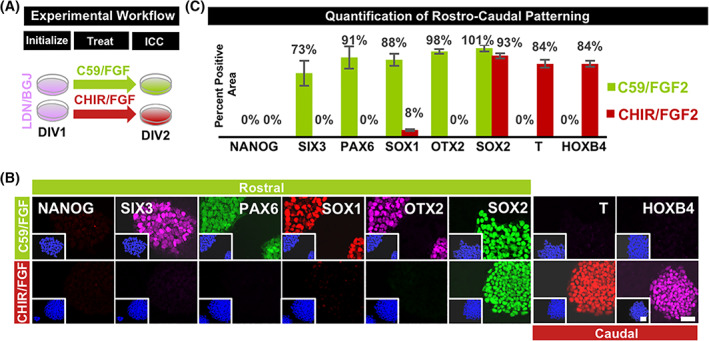FIGURE 3.

Treatment with LDN/BGJ unlocks immediate access to rostro‐caudal extremes of ectodermal patterning. A, Ectoderm derived using LDN/BGJ was exposed to either wntC59 (500 nM) and FGF2 (10 ng/mL) or CHIR99021 (4 μM) and FGF2 (10 ng/mL) to produce either forebrain or neuromesoderm phenotypes by 48 hours in vitro. B, Rostral landmarks upregulated following treatment with wntc59 include SIX3, PAX6, and OTX2; but not caudal neuromesodermal landmarks T and HOXB4. Conversely, caudal neuromesoderm landmarks SOX2, T, and HOXB4 were upregulated; but not rostral forebrain landmarks SIX3, PAX6, and OTX2. C, Differentiation was seen to be greater than 70% efficient in either rostro‐caudal direction. Quantification indicates averages and SE for three unrelated hiPSC lines. Nuclei stained blue with DAPI. Scale bars = 50 μm. BGJ, fibroblast growth factor pathway inhibitor BGJ398; C59, wnt pathway inhibitor WNTC59; CHIR, wnt pathway agonist CHIR99021; DAPI, 4′,6‐diamidino‐2‐phenylindole dilactate; DIV, days in vitro; E8, Essential 8; FGF2, fibroblast growth factor 2; hiPSCs, human induced pluripotent stem cells; hPSC, human pluripotent stem cell; LDN, bone morphogenic protein pathway inhibitor LDN193189
